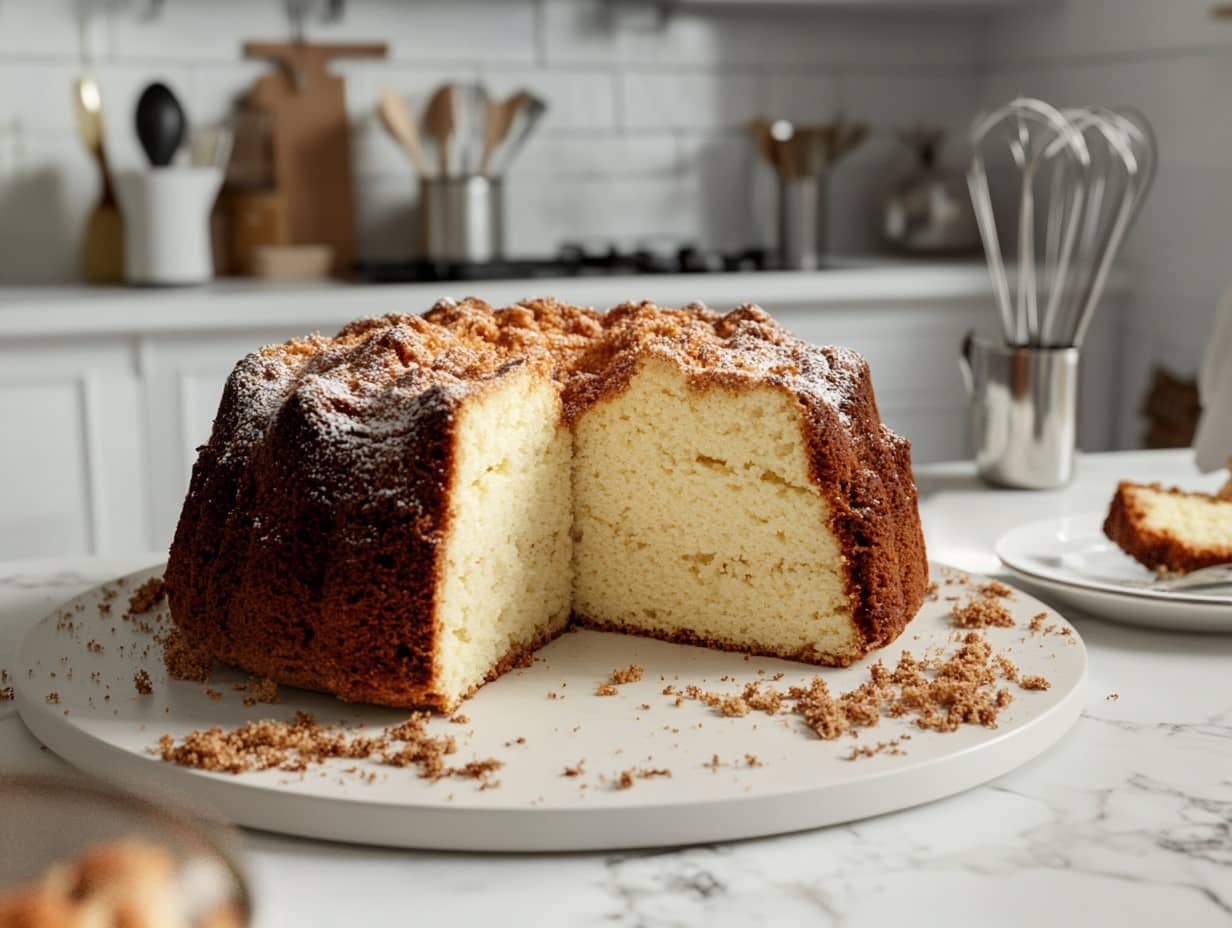The Secret to a Perfectly Moist Pound Cake
How do you keep pound cake moist? Have you ever baked a pound cake only to end up with a dry, crumbly slice that left you disappointed? You’re not alone. If you’ve struggled to keep your pound cake moist, you know how frustrating it can be. But don’t worry keeping a pound cake moist is easier than you think, and I’m here to share the secrets!
In this post, I’ll show you exactly how to keep your pound cake soft, tender, and melt-in-your-mouth delicious every time. Whether you’re a seasoned baker or a beginner, the tips and techniques you’ll learn will ensure that your next cake stays moist and flavorful from the first bite to the last.
We’ll dive into the key ingredients and baking techniques that make all the difference, and I’ll also share some expert tricks for storing your cake to keep it fresh. By the end of this article, you’ll have all the tools you need to bake the perfect pound cake that’s both moist and irresistible. Let’s get started!
Table of Contents
Why Moisture is Important in Pound Cake
When it comes to pound cake, the texture is everything. You want a cake that’s moist but not soggy, light but not airy, and dense but not dry. It’s that perfect balance that makes each bite a little piece of heaven. The key to achieving this? Moisture. Without enough moisture, your pound cake will end up being dry, dense, and unappetizing. The right amount of moisture ensures that the cake stays soft, tender, and holds up well over time. Plus, a moist cake has a rich flavor that’s hard to beat!
Key Factors for Moisture in Pound Cake
Keeping your pound cake moist is not just about one ingredient it’s about how all the components work together. Let’s take a closer look at the ingredients and techniques that will ensure your cake stays moist and flavorful from the first slice to the last.
The Role of Ingredients in Moisture Retention
The ingredients you choose play a huge role in the texture and moisture of your pound cake. While butter is often the star of the show in pound cakes, there are a few other key players that shouldn’t be overlooked.
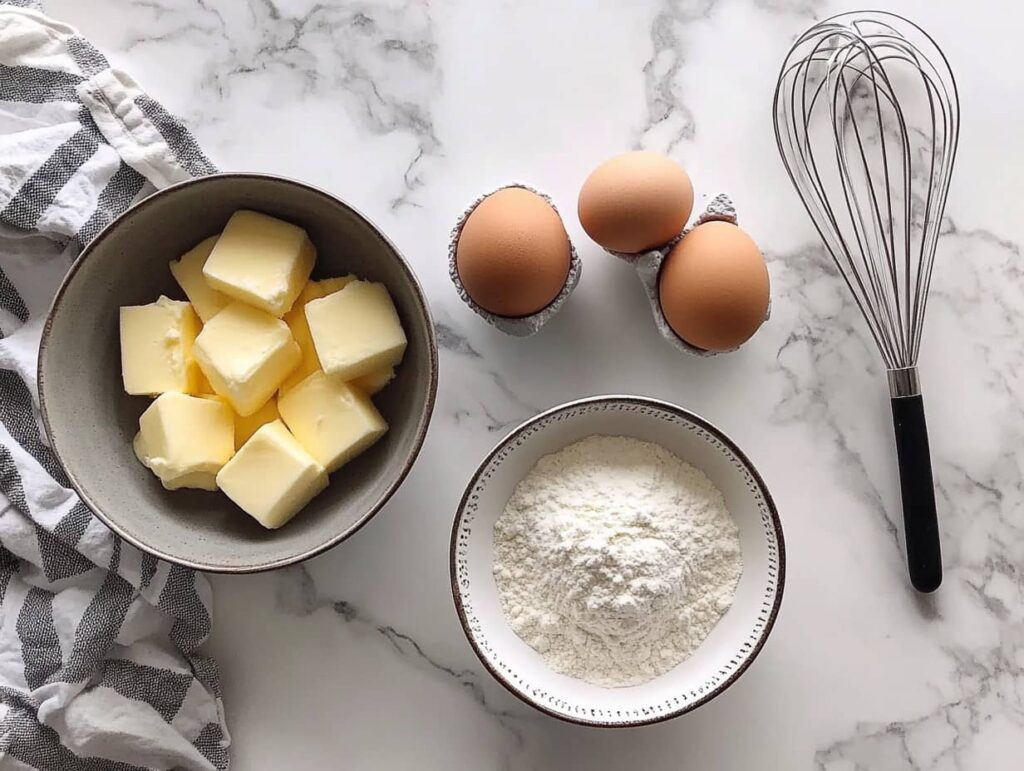
Butter vs. Oil: Which Is Best for Moisture?
Butter is a classic choice in pound cake recipes, and for good reason! It gives the cake a rich flavor and tender crumb. But when it comes to keeping the cake moist, oil can be your secret weapon. Unlike butter, oil stays liquid at room temperature, which helps the cake retain moisture for a longer time. This is why some bakers choose to combine both butter and oil for the best of both worlds flavor from the butter and moisture from the oil.
However, if you’re looking for a softer, more tender crumb, oil is often the better choice. For a slightly firmer, richer cake, butter might be the way to go. It’s all about finding the right balance for your taste!
The Importance of Eggs in Keeping Pound Cake Moist
Eggs do more than just hold your cake together they’re also crucial for moisture. Eggs help bind the batter, which gives your cake structure, and they also trap air during mixing, helping to keep your pound cake light. But their real magic lies in their ability to retain moisture during baking. If you’ve ever made a cake with too few eggs, you may have noticed it can turn out dry. On the other hand, too many eggs can make the cake dense and rubbery. So, getting the right number of eggs is key to maintaining that perfect texture.
Adding Sour Cream or Yogurt for Moisture
If you’re looking to take your pound cake’s moisture to the next level, consider adding sour cream or yogurt. These ingredients not only contribute moisture, but they also add a slight tanginess that can make your cake even more flavorful. Sour cream and yogurt contain fats that help keep your cake tender, while also helping it retain moisture during baking. If you’re experimenting with your recipe, try swapping out a small amount of the liquid for sour cream or yogurt to see how it affects the texture!
For more on creating the perfect texture, check out Why a Cold Oven is the Secret to a Better Pound Cake.
The Right Flour for Moisture-Rich Pound Cake
Not all flours are created equal. All-purpose flour is the go-to for most baking, but it’s not always the best choice when you want to keep your pound cake moist. For a moister, more tender crumb, you might want to try using cake flour. Cake flour has a lower protein content than all-purpose flour, which helps reduce the development of gluten. This results in a softer, more delicate cake that’s perfect for keeping moisture locked in.
Now, if you’re sticking with all-purpose flour, don’t worry! Just be sure not to overmix your batter, which can develop too much gluten and make your cake dry and tough.
Techniques to Ensure Moisture During Baking
It’s not just about what you put into the batter it’s also about how you bake it. Even if you have the best ingredients, using the wrong techniques can still lead to a dry pound cake. Here are some key baking tips to help you keep your cake moist:
The Correct Oven Temperature and Baking Time
One of the biggest mistakes people make when baking pound cake is setting the oven temperature too high or baking it for too long. Pound cakes need time to bake slowly and evenly. If the oven is too hot, the cake will bake too quickly on the outside, causing the interior to dry out before it’s fully cooked. To avoid this, set your oven to a moderate temperature around 325°F (163°C) is ideal for most pound cakes.
It’s also important to monitor the baking time. A typical pound cake takes about 60-70 minutes to bake, but this can vary depending on the size of the pan and the ingredients used. The best way to check if your cake is done is to insert a toothpick into the center. If it comes out clean, your cake is ready!
How to Avoid Overmixing Your Batter
It might be tempting to mix your batter until everything is fully combined, but overmixing can lead to a tough, dry cake. The more you mix, the more gluten you develop, and that can make your pound cake dense and dry. The key is to mix just until the ingredients are combined. If you see a few lumps, that’s okay don’t worry about it! Your cake will still come out tender and moist.
Using the “Wet Cake Test” to Check Moisture
Wondering if your cake is turning out moist? Try the “wet cake test.” When you check for doneness, the toothpick should come out with a few moist crumbs stuck to it this means the cake is moist inside. If it comes out completely clean, your cake might be a little too dry. Keep an eye on your cake as it bakes, and you’ll soon master the art of moisture retention!
Looking for more tips? Read our guide on Why Is My Chocolate Pound Cake Dry?.
Common Mistakes That Dry Out Pound Cake
Even experienced bakers can make mistakes that lead to a dry pound cake. Let’s go over some common errors to avoid so your cake turns out moist every time.
Overbaking: The Silent Moisture Killer
One of the worst things you can do to a pound cake is overbake it. While a slightly underbaked cake is forgivable (you can always pop it back in the oven), an overbaked cake is a total loss. Overbaking dries out the cake and causes it to lose its soft, moist texture. So, how do you avoid it? Keep an eye on the clock, use the toothpick test, and don’t be afraid to take the cake out a little early if you notice it’s baking faster than expected.
Using the Wrong Pan Size and Its Impact on Moisture
Choosing the right pan is crucial for ensuring a moist pound cake. If your pan is too small, the cake will rise too quickly and the edges may dry out before the center is fully baked. On the other hand, a pan that’s too large can cause the cake to bake too quickly, leading to a dry crumb. Always use a pan that’s the right size for your recipe typically an 8-inch or 9-inch round or loaf pan works best for a traditional pound cake.
How Incorrect Mixing Can Affect Your Cake’s Moisture
As mentioned earlier, mixing your batter too much can develop too much gluten, which will make your pound cake dry. But under-mixing isn’t ideal either. If your batter isn’t mixed enough, the ingredients won’t be fully combined, which can lead to uneven texture and moisture. Finding that sweet spot where the batter is mixed just right is key to a perfect, moist cake.
By now, you’ve got a good idea of the ingredients and techniques that can help you keep your pound cake moist. But it doesn’t stop there! In the next part, we’ll dive into how to keep your pound cake moist after baking and explore some expert tips to extend its shelf life. Stay tuned!
If you’re experimenting with flavors, try our recipe for Rich and Buttery Chocolate Pound Cake.
How to Keep Pound Cake Moist After Baking
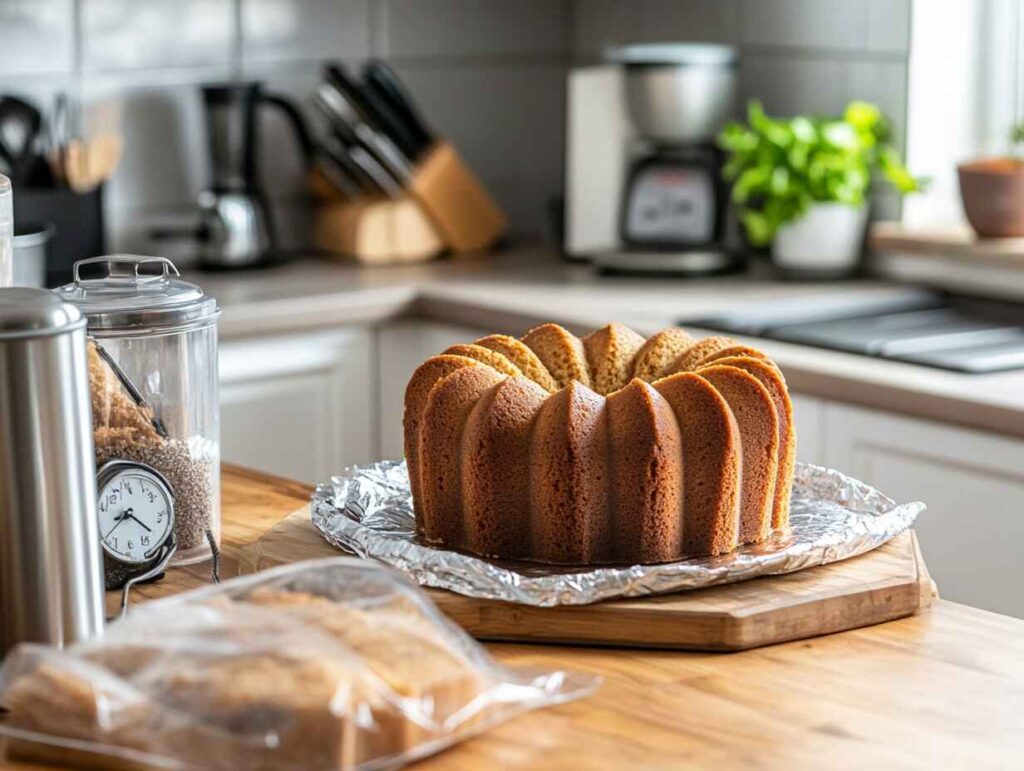
Now that your pound cake is baked to perfection, it’s time to talk about how to keep it moist after it comes out of the oven. Many people overlook this step, but how you store and handle your cake after baking can make a huge difference in whether it stays fresh and moist or dries out. Let’s go over the best practices to preserve that wonderful moisture in your pound cake.
Storing Pound Cake: Best Practices for Moisture Retention
Proper storage is key to maintaining the freshness and moisture of your pound cake. While it might be tempting to leave it out on the counter in an open dish, this will cause it to dry out quickly. Here’s how to store your pound cake the right way:
Room Temperature vs. Refrigeration
For the first few days after baking, the best place to store your pound cake is at room temperature. Place it in an airtight container or wrap it tightly in plastic wrap. This will keep the cake moist and fresh without compromising its texture. But be careful room temperature storage is ideal only if you plan to eat it within a few days. If you’re not planning to finish it within that time frame, refrigerating it is the better option.
While refrigeration is great for long-term preservation, it can sometimes cause your pound cake to dry out. If you do need to refrigerate it, make sure it’s wrapped well in plastic wrap or stored in a sealed container to prevent it from absorbing odors and moisture from the fridge. To revive the cake, simply warm it up for a few seconds in the microwave or oven before serving.
Wrapping and Sealing the Cake for Freshness
Wrapping your pound cake is an essential step in preserving its moisture. Use plastic wrap to tightly seal the cake and prevent air from drying it out. If you don’t have plastic wrap, you can also use aluminum foil, but plastic wrap works best to keep the cake soft. If your cake is in a large loaf or a bundt shape, you can even wrap it whole before slicing to maintain maximum moisture retention.
For extra protection, you can also place the wrapped cake inside a larger airtight container to create a double layer of moisture preservation. This works particularly well if you’re storing the cake in a humid environment where moisture can easily escape.
Freezing Pound Cake for Long-Term Moisture Preservation
Freezing is one of the best ways to keep your pound cake moist for a longer period of time, especially if you’ve baked a large quantity. Freezing allows you to preserve the cake’s freshness and prevent it from drying out. Here’s how to freeze pound cake properly:
- Let the cake cool completely before wrapping it. This prevents condensation from forming inside the wrapping, which can make the cake soggy.
- Wrap the cake tightly in plastic wrap, then in a layer of aluminum foil for added protection.
- Place the wrapped cake in a freezer-safe zip-top bag or airtight container. Squeeze out as much air as possible to prevent freezer burn.
- When you’re ready to enjoy your cake, thaw it at room temperature for several hours or overnight. You can also microwave individual slices for a quick and moist treat.
Freezing your pound cake not only preserves moisture but also allows you to enjoy your cake months after it’s been baked. Just be sure to follow the wrapping instructions carefully, and your cake will taste fresh and delicious when it’s thawed.
Enhancing Pound Cake Moisture with Toppings and Glazes
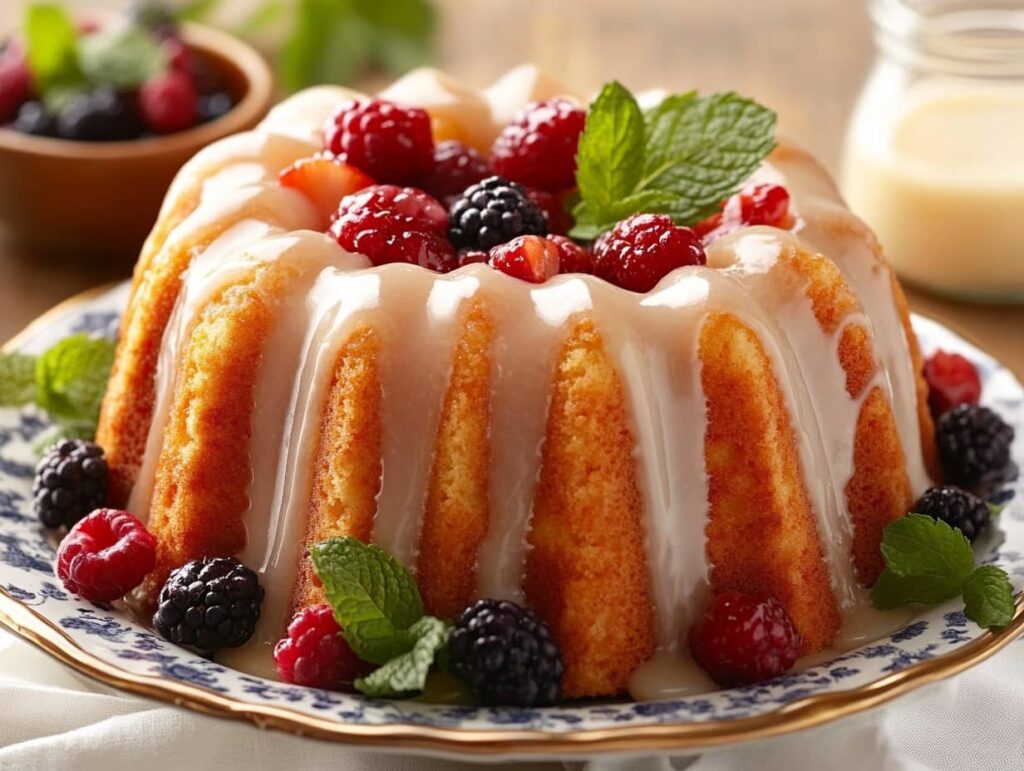
If you want to elevate the moisture and flavor of your pound cake even further, consider adding some delicious toppings and glazes. These additions not only enhance the flavor but also contribute extra moisture, keeping your cake even juicier and more irresistible. Here are a few ideas:
The Magic of Simple Syrups and How to Use Them
Simple syrup is a fantastic way to add moisture to your pound cake after it’s baked. It’s easy to make with just two ingredients: sugar and water. Simply heat the sugar and water together until the sugar dissolves, and let it cool before brushing it onto your cake. The syrup will soak into the cake, keeping it moist and adding a subtle sweetness.
For an extra flavor boost, you can infuse the simple syrup with vanilla, citrus, or even herbs like mint or rosemary. The key is to brush the syrup onto the cake while it’s still slightly warm, allowing the moisture to absorb without making the cake soggy.
Adding Fruit or Whipped Cream to Boost Moisture
Another great way to enhance the moisture of your pound cake is by adding fresh fruit or whipped cream. Berries like strawberries, raspberries, or blueberries are particularly good choices because they release natural juices that add moisture. You can either layer the fruit on top of your cake or serve it as a side.
Whipped cream is also an excellent pairing for pound cake, especially when it’s freshly made. It adds a rich, creamy texture that complements the moistness of the cake. If you’re looking to take it a step further, try adding a drizzle of flavored syrup or a sprinkle of powdered sugar for extra sweetness!
FAQ: The Secret to a Perfectly Moist Pound Cake
How do you keep a pound cake moist?
To keep your pound cake moist, focus on using the right ingredients, such as butter, oil, and eggs. Also, pay attention to your baking techniques, like setting the correct oven temperature, avoiding overmixing, and storing the cake properly afterward. Simple syrups and fruit toppings can also enhance moisture.
What ingredients help keep pound cake moist?
Key ingredients include butter for flavor, oil for moisture retention, eggs for structure, and sour cream or yogurt for extra tenderness. Using cake flour instead of all-purpose flour can also result in a more tender, moist cake.
Should I use butter or oil for moisture in pound cake?
While butter provides rich flavor, oil is better for moisture retention due to its liquid state at room temperature. A combination of both can offer the best of both worlds richness from the butter and moisture from the oil.
Conclusion: How do you keep pound cake moist?
By now, you’re armed with all the knowledge you need to keep your pound cake moist and delicious. From the right ingredients and baking techniques to post-baking storage and creative topping ideas, you’ve got everything it takes to bake a perfect, moisture-rich pound cake every time. Remember, the secret to a moist cake lies in the balance finding the right combination of ingredients, time, and techniques that work for you.
So next time you bake a pound cake, don’t be afraid to experiment with these tips and tricks. Whether you’re making a classic pound cake or adding your own twist, the key is to keep it moist and flavorful. Happy baking!
Print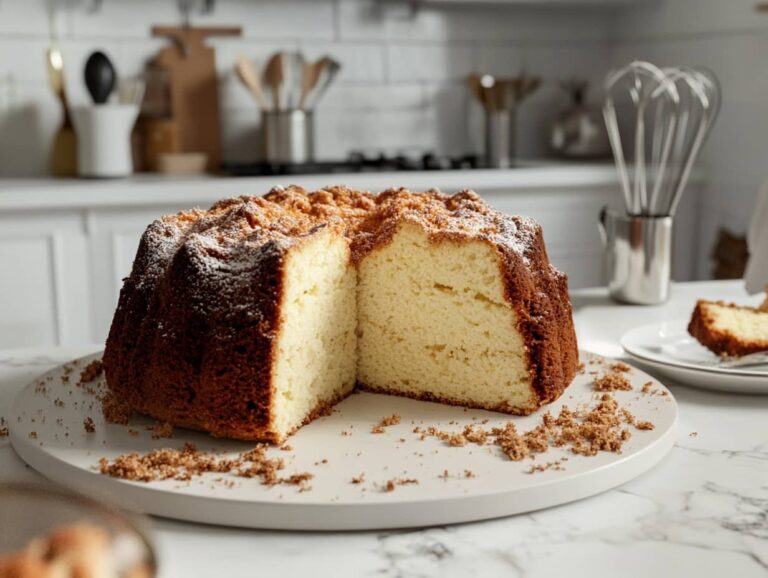
How Do You Keep Pound Cake Moist? Expert Baking Tricks You Need to Try
This moist pound cake is rich, buttery, and soft, with a tender crumb that stays moist for days. Made with sour cream for extra moisture and brushed with a simple syrup, it’s the perfect classic dessert for any occasion!
- Total Time: 75 minutes
- Yield: 10-12 servings
Ingredients
For the Cake:
- 1 cup (226g) unsalted butter, softened
- 2 cups (400g) granulated sugar
- 4 large eggs
- 1 tsp vanilla extract
- 2 ¾ cups (344g) all-purpose flour
- ½ tsp baking powder
- ½ tsp salt
- 1 cup (240ml) sour cream
For the Simple Syrup:
- ½ cup (100g) sugar
- ½ cup (120ml) water
- 1 tsp vanilla extract
Instructions
- Preheat & Prep – Preheat oven to 325°F (163°C). Grease and flour a 9×5-inch loaf pan.
- Cream Butter & Sugar – Beat butter and sugar until light and fluffy, about 3-4 minutes.
- Add Eggs & Vanilla – Mix in eggs one at a time, beating well after each. Add vanilla extract.
- Combine Dry Ingredients – In a separate bowl, whisk together flour, baking powder, and salt.
- Alternate Additions – Add flour mixture and sour cream to the batter in three additions, beginning and ending with flour. Mix until just combined.
- Bake – Pour batter into the pan and bake for 55-65 minutes, or until a toothpick comes out with a few crumbs.
- Make the Syrup – While the cake bakes, heat sugar and water until sugar dissolves. Remove from heat and stir in vanilla.
- Brush with Syrup – While the cake is warm, brush syrup over the top to lock in moisture.
- Cool & Store – Let cool in the pan for 15 minutes, then transfer to a wire rack. Wrap tightly once cool.
Notes
- Room Temperature Ingredients: Ensure butter, eggs, and sour cream are at room temperature for a smooth batter.
- Avoid Overmixing: Overmixing can make the cake dense and dry mix just until combined.
- Check for Doneness Early: Ovens vary, so start checking at 55 minutes with a toothpick.
- Flavor Variations: Add lemon zest, almond extract, or a swirl of cinnamon sugar for a twist.
- Storage: Wrap in plastic wrap and store at room temp for up to 4 days or freeze for up to 3 months.
- Prep Time: 15 minutes
- Cook Time: 60 minutes
- Category: Dessert
- Method: Baking
- Cuisine: American

